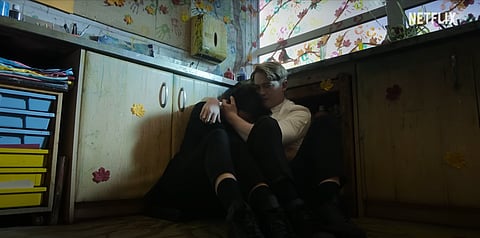When Heartstopper first arrived in 2022, the gush of queer joy it elicited was unmatched. In a landscape where queer representation is perennially doused in grief and tragedy, the Netflix adaptation of Alice Oseman’s chart-busting eponymous graphic novels (by Oseman herself) held vibrant, radical freshness. But here’s a caveat. The high school romance between Charlie Spring (Joe Locke) and Nick Nelson (Kit Connor) can’t quite shake off signs of a sweet but brief sensation. Stretch it too much and the bright, beaming queer world of Heartstopper risks collapsing. In Season 3, the efforts to dial up charm and pleasure occupy an uneasy space with the ‘adult issues’ Oseman wants to tackle.
Heartstopper Season 3 Review: Queer YA Romance’s Airbrushed Tone Gets In The Way Of Growth
The once-enchanting show feels too manicured to charm
So there’s Charlie’s eating disorder, hinted at in the earlier season, dominating the first half of this one. He tucks it out of conversation and evades Nick’s concerns. As Charlie’s mental health plummets, Nick is overwhelmed in his constant attempts to be the perfect, all-encompassing emotional plank for him. It’s his aunt who puts things in perspective: “Love can’t cure mental illness”. People need more support than what one person can give, she gently tells Nick, who’s guilt-ridden over not being able to make Charlie open up and heal.
In their friend circle, Tao (William Gao) too overcompensates in showing affection towards his girlfriend, Elle (Yasmin Finney), who’s all set to move away and join an art school. Tao has abandonment issues. He fears Elle might forget him in her new setting. Therefore he plans an elaborate summer of love, taking her out on dates every day. Gao’s disarming as he channels Tao’s lovable, sincere awkwardness and dry wit.

The season is shaded with a hyper-consciousness of the characters, most of them sixteen, nearing adulthood. Hence intimacy, navigating bodies and pleasure get messier. While the focus in this regard stays expectedly on Charlie and Nick, it’s in the moments where Tao and Elle approach sex that the show feels stirringly authentic and particular. Director Andy Newbery handles Elle’s gender dysphoria with sensitivity and precision. Elle is most comfortable around Tao. Yet as someone who has just transitioned, there are still pangs of bodily unease she has to negotiate with sex.
But the show’s saccharine flavour invariably hijacks the truth of darker, character-driven moments it strides into. Unhealthy dependency which can creep into love and body image angst—the narrative slant to these remains nominal. It’s a show that is ever-eager to smoothen out the creases irrespective of any situation’s dramatic stakes. So an episode arrives midway through the season to show how Charlie’s anorexia finds a sort of restorative upshot. This key strand recedes soon after.
Oseman operates from a space of gentleness, decency and compassion. Charlie clashes with his mother, who is said to have ‘anger issues’ often, but frankly her only reservations about his growing intimacy with Nick seem to exist only for an obligatory scene where she mourns the cyclicality of her turning into a version of her own super-controlling mother.
The show makes no bones about embracing its inherent bubble-gum fantasy lens on teenage and queerness. It’s the very hook of Oseman’s narrative universe. It was why the story felt irresistible in the first place. But how long can an entire show coast off a spirit of cutesy determined to blunt all hard edges?

Every crisis the circle of friends has wraps up swiftly or is shoved to the fringes, superseded by yet another act of kindness. Each of them is wonderful, nice and accommodating; any grouse one may have towards the other dissipates so simply you will think the briefest flares of fallout have been written in an idle afterthought. There’s no room for spite, bitterness or grudges here. If Isaac (Tobie Donovan), who identifies as asexual and aromantic amidst a friend circle filled with couples, feels put aside with none of them having any time for him, the show settles the matter by giving him one outburst scene and the others struck by sorry realisation. You can also take the example of Imogen (Rhea Norwood) who comes to terms with her pansexuality and a sudden romantic interest in a childhood friend. Hurt peppers this equation. There’s misreading of cues between friends regarding boundaries. Nevertheless in the world of Heartstopper, no rift lingers and creates its own vicious underside.
As a result, characters, once sparkling in the first season with human uncertainties, shrink into cardboard cutouts. A sense of vitality, the confusing rush of teenage emotions, the hormonal surge-these key elements are swapped for a fast-growing clarity that strikes as implausible and flat-out ridiculous. Oseman whispers about troubles her characters confront and artlessly dashes ahead with the narrative. In the season’s later half, Nick is in a dilemma over choosing a university which both aligns with his interest and is close enough home for him and Charlie to be together. Of course, he can only pick one. But even these anxieties get papered over by the blossoming romance.
There’s too much affectation and tidiness here which detract from the show’s sublime gestures of keeping the queer spectrum always wide open and inclusive. Heartstopper may have just run its course.

